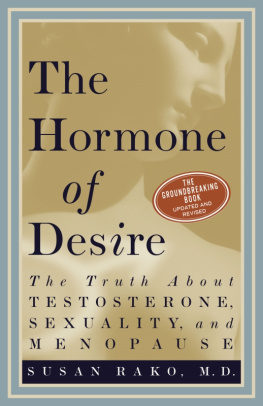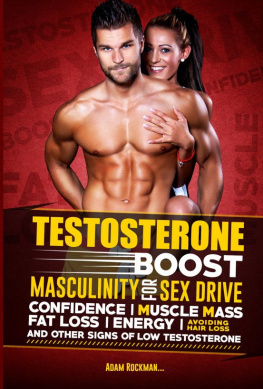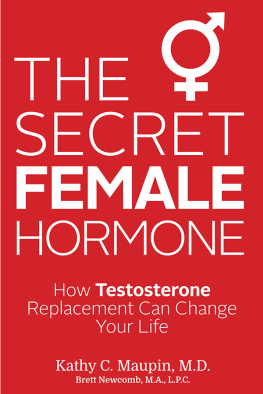Testosterone Revealed
How to Boost Testosterone Levels, Sex Drive, Muscle Mass and the Truth about Hormone Therapy
Introduction
Low testosterone or hypogonadism (the condition where levels of testosterone in the body is lower than normal), is a common disease in most parts of the world. For instance, in the USA alone almost
10% men over 30,
15% men over 40,
25% men over 50,
35% men over 65 and
40% men over 75
face issues related to low levels of testosterone. The level of awareness about hypogonadism also leaves a lot to be desired.
A few hundred years ago, degenerative mental conditions like Alzheimers and Dementia were thought of as age induced senility and loss of memory and other cognitive abilities and were considered normal as one aged. It is only recently that these were identified as bona fide diseases and the since then, the number of people found to suffer from these diseases has reached epidemic proportions.
Similarly, people have started paying due attention to hypogonadism only recently. Symptoms of hypogonadism are still considered a part of normal aging by a vast majority of people on earth, and it will take some time before it is treated as a disease and given due attention. This has also resulted in less research being done on the subject so far than what it deserves. Let us take a look at the history of testosterone treatment.
On June 1, 1889, Charles douard Brown-Squard, a French physiologist over 70 years old, reported having injected himself with a substance extracted from the testicles of guinea pigs and dogs. The injections, in his own words, ''had increased his physical strength and intellectual energy, relieved his constipation and even lengthened the arc of his urine''
In 1918, in San Quentin, a prison doctor called Dr. Leo L. Stanley, consistently reported restored health and potency after transplanting testicles of executed prisoners to those with depleted vitality. Dr Stanley eventually started substituting testicles from rams and goat and deer in less than vital prisoners and even that was a huge success. So much so that people from all walks of society actively sought him out. The prestigious Journal of Endocrinology also published his papers.
By 1935, researchers had identified testosterone as the essence of manhood.
The Journal of the American Medical Association published a paper on low testosterone level called ''The Male Climacteric'' on April 15, 1939. In it, testosterone therapy was recommended for the first time.
Back then, pushing testosterone via painful injections was the only delivery method. A patch was introduced in the 1990s but it met with limited success. In June 2000, Unimed Pharmaceuticals began selling Androgel a gel that just had to be rubbed into the skin. Gradually, many more delivery methods have come into existence and we shall find more about all that later in this eBook.
Copyright 2014 by Dave Erickson Media - All rights reserved.
This document is geared towards providing exact and reliable information in regards to the topic and issue covered. The publication is sold with the idea that the publisher is not required to render accounting, officially permitted, or otherwise, qualified services. If advice is necessary, legal or professional, a practiced individual in the profession should be ordered.
- From a Declaration of Principles which was accepted and approved equally by a Committee of the American Bar Association and a Committee of Publishers and Associations.
In no way is it legal to reproduce, duplicate, or transmit any part of this document in either electronic means or in printed format. Recording of this publication is strictly prohibited and any storage of this document is not allowed unless with written permission from the publisher. All rights reserved.
The information provided herein is stated to be truthful and consistent, in that any liability, in terms of inattention or otherwise, by any usage or abuse of any policies, processes, or directions contained within is the solitary and utter responsibility of the recipient reader. Under no circumstances will any legal responsibility or blame be held against the publisher for any reparation, damages, or monetary loss due to the information herein, either directly or indirectly.
Respective authors own all copyrights not held by the publisher.
The information herein is offered for informational purposes solely, and is universal as so. The presentation of the information is without contract or any type of guarantee assurance.
The trademarks that are used are without any consent, and the publication of the trademark is without permission or backing by the trademark owner. All trademarks and brands within this book are for clarifying purposes only and are the owned by the owners themselves, not affiliated with this document.
Chapter 1: What is Testosterone?
A Primer
Testosterone is a hormone. A hormone is a chemical substance secreted by a tissue that travels via body fluids and affects other tissues. Hormones are, in effect, chemical messengers that communicate between tissues. Testosterone, though it is usually associated with males, is also present in females as well (in fact, it is essential for any human being irrespective of whether you are a male or a female). It is not a male monopoly.
Sex hormones testosterone for males and for females vary in the levels they are present in us. They vary by the hours and minutes depending on how much they are released by the respective glands.
In fact, you would see that some women have more than average facial hair and muscles. Sometimes, women have more than required amounts of testosterone. Excess testosterone prevents women from getting pregnant and needs to be treated.
But, at the end of the day, it is the male hormone. This is what makes us men. It is the reason rugby, boxing, soccer, WWF, cricket, and many more sports like these are usually called male dominated sports. Let us find out the roles of testosterone in men. Testosterone is the reason for the existence of feminism.
Well, now let us take a deeper look at testosterone and see what actually happens in our body. Hypothalamus, a part of our brain, releases gonadotropin releasing hormone (GnRH from now on) to our pituitary gland. GnRH aids the pituitary gland in producing and releasing two hormones, follicle-stimulating hormone (FSH) and luteinizing hormone (LH), both known as gonadotropins. LH, along with (of all things!) cholesterol, aids the testes in producing testosterone.
Yes! Cholesterol is of some use at least! The public enemy number one, the villain, cholesterol. I was surprised to find out, cholesterol is an essential substance needed in a lot of other ways. In fact, it is needed for almost anything. But for now, lets concentrate on testosterone only.
When the testosterone levels become adequate, the pituitary gland slows down the release of LH to cut off any further production of testosterone. FSH is involved in regulation of sperm production.
The Role of Testosterone in Males:
Testosterone plays a vital role even during prenatal development. It plays a role in determining the gender of the embryo as well. It is involved in the development of sex organs and the prostate gland and even has an effect on brain development.
Testosterone is responsible for "brain masculinisation" in infants.
During childhood, testosterone helps with the growth of pubic hair, auxiliary hair, and appearance of hair on the upper lips. Males do witness a growth spurt due to bone maturation right before adolescence.
In adolescence, most boys get a deeper voice, their facial features develop male characteristics, muscle start increasing, shoulders tend to become broader, and the skin becomes oily due to enlargement of the sebaceous glands. All thus happens due to a surge in testosterone production.





